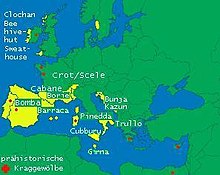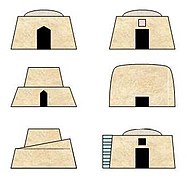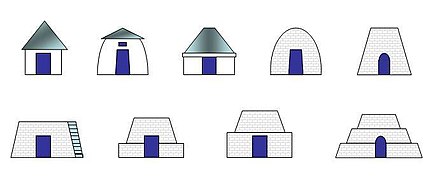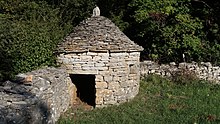Cantilever vaults made of dry masonry
Cantilever vaults made of dry masonry have belonged to the rural buildings since the Stone Age up to the present, which were erected in various regions of Europe using a tholos-like technique, which - according to current knowledge - first appears in Cyprus . Examples can be found around the Mediterranean , but the Neolithic cultures of Brittany , Great Britain and Ireland also used them as chamber ceilings in megalithic systems (e.g. Cairn von Barnenez , domed structures in the Hebrides and Newgrange ). For the shape and statics of the vault, see cantilever vault .
The corbelled from small-scale natural flat stones (no pebbles ) is common in the rural areas to modern times. One of the last drywall stalls in Ireland was built on the Dingle Peninsula in 1960 .
distribution
Many round and rectangular buildings were built in the early Middle Ages. In the English-language literature, the stone round huts went down as beehive huts , the domed buildings of the Hebrides as "beehive shielings". A rectangular shape of the dry walled vault was created with the Naveta in the Balearic Islands . The early Christian Gallarus Oratory on the Dingle Peninsula in County Kerry in Ireland or the large stone hut near Gordes (in the Vaucluse department ) in Provence are also vaulted buildings on a rectangular basis.
Stone domed buildings used in rural areas that do not continue an older megalithic tradition can be found in Istria ( Kažun and Komarda) and on the Dalmatian Adriatic coast ( Bunje on Brač , or the Trim on the island of Hvar ), in Slovenia (Hiska and Koca) Pinnetta in Sardinia and Sicily (the Cubburo or Pagghiaru ). In Switzerland (in the Poschiavo valley ) they are called Scelé or Crotto . There is evidence of domed buildings in Bohuslän, Sweden, and Iceland. The Menorcan Baracca, the Spanish Catxirulo1 and Bombo (built as a museum in Tomelloso), the Cubburo and the Dammuso in Sicily and Pantelleria , the Apulian Trullo , the Borie and the Cabane in southern France are used or were used for agriculture in the former megalithic areas , the Girna on Malta , and sometimes very complex stone huts (Chafurdão with and Choça without supporting vaults) in Portugal and the Hebrides .
Traditional folk architecture is rich in regional patterns conditioned by geomorphological features, climate and therefore vegetation, historical and sociocultural factors, economic base and the continuity of traditional expression.
research
British, French, Italians, Yugoslavs, Portuguese, Spaniards, Basques, Swiss and the German Gerhard Rohlfs were the first to describe rustic vaulted buildings from around 1912. Rohlfs shows that Europe was literally covered by small domed buildings. But he primarily devoted himself to the trullo and mentions z. B. the Maltese Giren, as well as the Sicilian domed buildings and the Anatolian dome cisterns not.
Examples
Beehive hat
Beehive hut or beehive hut is the generic name of the buildings erected in the British Isles . The specimens are called Clochán in Irish .
On the Hebridean island of Lewis there is an interior design described by FWL Thomas in 1858 and A. Mitchell in 1880, which is otherwise characteristic of megalithic systems . In particular, the triple niche of the Newgrange-type passage tombs stands out. Threshold stones that separate these niches indicate sacred buildings. The subsequent use of such buildings for profane purposes is evidence of some local structures. An only periodically inhabited hut ( Airigh A 'Sguir ), as which these buildings were used at the time of their discovery, would have coped with a much simpler design.
Borie, Cabane, Casela and Gariotte
The Borie is a Provencal stone house with a pointed roof that may look similar to the Sardinian pinedda and huts on the eastern Adriatic coast. The name Borie comes from the late 19th century. Such cantilever vaults can be found in southern France, among others in the Alpes-Maritimes region . They apparently come from neighboring Liguria and have been around since around 600 BC. In the Maritime Alps . Old bories are often found close to or even within Ligurian Oppida , where they probably had a cultic function like other domed buildings . The construction method was profaned in Christian times and can be found here in old sheep farms, where they have been doing their services until recently. In other parts of the South of France, buildings constructed according to similar principles are called gariotte , cabane , capitelles or casela .
The Girna
Girna (plur. Giren) are the name of the field stables or shepherds' huts that can be found in the still unpopulated half of Malta and on Gozo . Aleksandra Faber was the first scholar to describe Malta's Giren in "Le Bunje". The construction method was still unknown during the Maltese temple phase on Malta and must have been used during the second settlement of Malta after 2000 BC. BC by Sicilian immigrants. In Sicily there are similar buildings near Mount Etna, whichare called Pagghiaru there.
- Malta and Apulia
The Kažun
The Kažun (plur. Kazuni ) is a type of field shelter occurring in the Croatian part of Istria , up to 30 m² in size, round or square.
The trullo
Trullo ( Italian ), plur. Trulli is a name for thehouses or stables that occurmainly in Apulia , the more well-known forms of which the stone roofs taper upwards like a pointed tip and are closed with a symbolic keystone. The scale-like dark stone roofs give the white trullo, which originally stood in the fields, its characteristic appearance. The "poor people's houses", which were forgotten until the middle of the last century, experienced a renaissance and are now being offered as holiday apartments. The Trulli of Alberobello , an original farm worker settlement are part of the UNESCO - World Heritage Site . But there are also a large number of completely differently designed trulli. Particularly noticeable examples are the round and square pyramid-like, single or multi-tiered or conical buildings.
gallery
Beehive hut on the Dingle Peninsula
Borie in the Luberon
Bombo in Spain
Barraca in Menorca
Cùbburo in Sicily
Trulli as holiday homes in Alberobello
Tazotas in the Doukkala region , Morocco
See also
literature
- Raffaello Battaglia: Ricerche Paleontologiche e Folkloristiche Sulla Casa Istriana Primitiva. In: Atti e Memorie della Societa Istriana di Archeologia e Storia Patria. Vol. 38, No. 2, 1926, ISSN 0392-0321 , pp. 33-79.
- Bories (= Luberon images et signes. 4). Edisud, Aix-en-Provence 1994, ISBN 2-85744-720-5 (A book about the Bories of Provence; in French; only available from Parc Natural Régional du Luberon).
- Michael Fsadni: The Girna. The Maltese Corbelled Stone Hut. Translated from the Maltese by Louis J. Scerri. Dominican Publication, Malta 1992.
- Gerhard Rohlfs : Primitive domed buildings in Europe (= Bavarian Academy of Sciences, Philosophical-Historical Class. Treatises. NF 43, ISSN 0005-710X ). Publishing house of the Bavarian Academy of Sciences, Munich 1957.
- Jürgen E. Walkowitz: The megalithic syndrome. European cult sites of the Stone Age (= contributions to the prehistory and early history of Central Europe. Vol. 36). Beier & Beran, Langenweißbach 2003, ISBN 3-930036-70-3 .
Web links
- stoneshelter.org
- Main features of a trullo on Alberobello.net
- secwepemc.org
- tomelloso.es

















